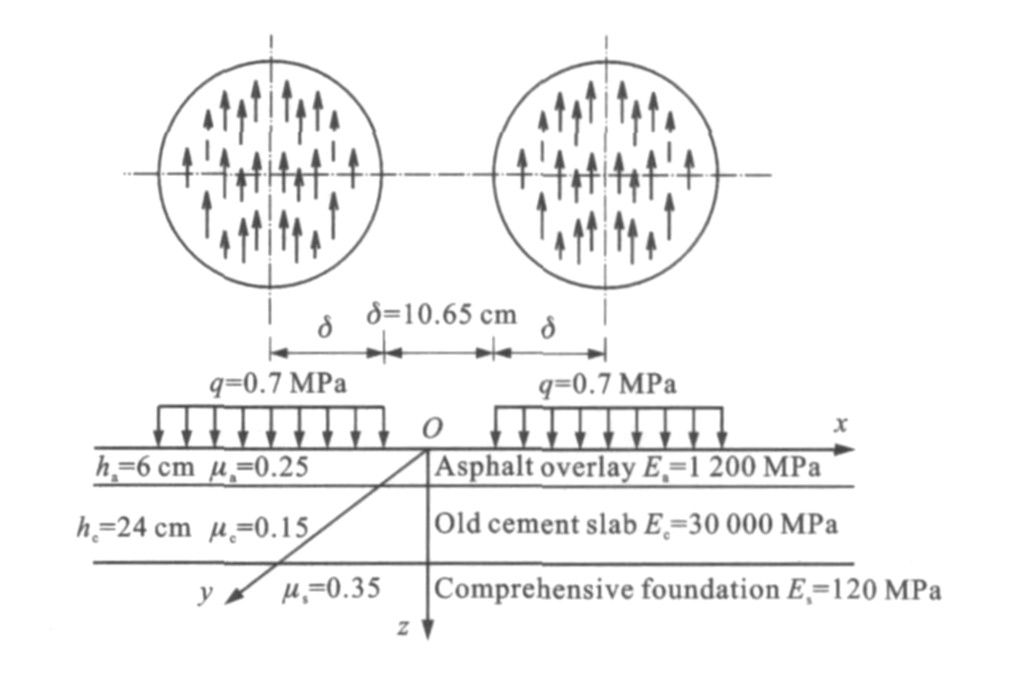Black and white interlaminar instability failure of asphalt overlay on old cement slab
-
摘要: 为分析旧水泥板沥青加铺层黑白层间水平剪切滑移和界面粘结两类失稳性破坏, 通过复合结构弹性理论计算、MATLAB编程、层间剪切和拉拔试验, 揭示了车速、路面附着系数、竖向荷载、层间接触系数、加载速率、温度、粘层油洒布量等对层间极值应力应变、剪切强度和拉拔强度的影响规律, 分别建立了层间剪切强度与正应力、剪切速率、温度以及拉拔强度与拉拔速率、温度、粘层油洒布量的函数关系。分析结果表明: 15℃时拉拔破坏界面发生概率从大到小排序为水泥板表面、粘结层、沥青膜, 45℃时为粘结层、水泥板表面、沥青膜, 层间平均粘结强度随着上述排序的递减而增大; 为减少层间失稳性破坏, 应适当提高行车速度, 控制汽车轴载, 清洁和糙化水泥板表面, 选取适宜的粘层油洒布量, 液体石油沥青为0.20~0.40 L.m-2, 乳化沥青为0.48~0.60L.m-2, 并推荐以芯样平均拉拔强度和破坏界面位置作为加铺层施工质量检验判别依据。Abstract: In order to study the two kinds of instability failures between asphalt overlay and old cement slab such as black and white interlaminar horizontal shear slippage and interfacial bonding instability, the influence rules of vehicle speed, road adhesion coefficient, vertical load, interlaminar contact coefficient, loading rate, temperature and the spraying amount of viscous oil on interlaminar extreme stress and strain, shear strength and pull-out strength were revealed through the elastic theoretical calculation of composite structure, MATLAB programming, interlaminar shear test and pull-out test.The function relationships among interlaminar shear strength and normal stress, shear rate, temperature, and among pull-out strength and pull-out rate, temperature, the spraying amount of viscous oil were established respectively.Analysis result shows that the descending order of pull-out failure interface occurrence probabilities at 15 ℃ is cement slab surface, tack coat, asphalt membrane, the descending order at 45 ℃ is tack coat, cement slab surface, asphalt membrane, and average interlaminar bonding strength increases with the descending of above order.In order to reduce interlaminar instability failure, vehicle speed should be increased appropriately, vehicle axle load should be controlled, the clean and rough surface conditions of old cement slab should be kept, the spraying amount of viscous oil should be chosen appropriately, liquid petroleum asphalt is 0.20-0.40 L·m-2, and emulsified asphalt is 0.48-0.60 L·m-2.The average pull-out strength of core sample and interface failure position are recommended as distinguishinging bases for the construction quality of asphalt overlay.
-
Table 1. Calculation result of f
Pavementcondition Pavement type Vehicle speed/(km·h-1) 10 30 60 Dry Cement concrete 0.70-0.85 0.65-0.80 0.60-0.75 Asphalt overlay 0.70-1.00 0.65-0.85 0.5-0.65 Macadam pavement — 0.55-0.60 — Moist Cement concrete 0.60-0.70 0.40-0.60 0.35-0.55 Asphalt overlay 0.40-0.65 0.25-0.60 0.10-0.50 Macadam pavement — 0.35-0.40 — Table 2. Result of direct pull-out test
Pull-out damage interface Cement slab surface damage Tack coat damage Asphalt membrane damage Epoxy damage Experimental temperature/℃ 15 45 15 45 15 45 15 45 Damage number 19 9 6 13 4 6 1 2 Damage probability/% 63.33 30.00 20.00 43.33 13.33 20.00 3.33 6.67 Average bonding strength/MPa 0.518 0.496 0.645 0.314 0.707 0.511 Standard deviation of bonding strength/MPa 0.082 0.059 0.116 0.048 0.149 0.091 Table 3. Average interlaminar pull-out strengths under different spraying amounts MPa
Asphalt type Specification 15 ℃±1.5 ℃, spraying amount/(L·m-2) 45 ℃±1.5 ℃, spraying amount/(L·m-2) 0.2 0.4 0.6 0.2 0.4 0.6 Medium-curing liquid petroleum asphalt (Shangdong Sunshine) AL(M)-3 0.303 0.287 0.283 0.172 0.164 0.141 AL(M)-5 0.356 0.398 0.371 0.173 0.188 0.137 AL(M)-6 0.387 0.378 0.369 0.169 0.194 0.146 Quick breaking emulsified asphalt(Shell) PC-3 0.408 0.492 0.436 0.197 0.261 0.246 PA-3 0.329 0.407 0.406 0.193 0.227 0.227 -
[1] KRUNTCHEVA M R, COLLOP A C, THOM N H. Effect of bond condition of flexible pavement performance[J]. Journal of Transportation Engineering, 2005, 131(11): 880-888. doi: 10.1061/(ASCE)0733-947X(2005)131:11(880) [2] RAAB C, PARTL M N. Investigation into a long-term interlayer bonding of asphalt pavements[J]. Baltic Journal of Road and Bridge Engineering, 2008, 3(2): 65-70. doi: 10.3846/1822-427X.2008.3.65-70 [3] MA Xin, GUO Zhong-yin, LI Zhi-qiang, et al. Shear destruction mechanism of asphalt pavement under moving load[J]. China Journal of Highway and Transport, 2009, 22(6): 34-39. [4] BAEK J, OZER H, WANG Hao, et al. Effects of interface conditions on reflective cracking development in hot-mix asphalt overlays[J]. Road Materials and Pavement Design, 2010, 11(2): 307-334. doi: 10.1080/14680629.2010.9690278 [5] HU Xiao-di, WALUBITA L F. Effects of layer interfacial bonding conditions on the mechanistic responses in asphalt pavements[J]. Journal of Transportation Engineering, 2011, 137(1): 28-36. doi: 10.1061/(ASCE)TE.1943-5436.0000184 [6] LIU Li. Study on the technology performance of asphalt pavement layer interfaces[D]. Xi'an: Chang'an Univerisity, 2008. [7] LENG Z, AL-QADI I L, CARPENTER S H, et al. Interface bonding between hot-mix asphalt and various Portland cement concrete surfaces[J]. Transportation Research Record, 2009(2127): 20-28. [8] XU Qin-wu, ZHOU Qing-hua, MEDINA C, et al. Experimental and numerical analysis of a waterproofing adhe-sive layer used on concrete-bridge decks[J]. International Journal of Adhesion and Adhesives, 2009, 29(5): 525-534. doi: 10.1016/j.ijadhadh.2008.12.001 [9] ZHOU Qing-hua, XU Qin-wu. Experimental study of waterproof membranes on concrete deck: interface adhesion under influences of critical factors[J]. Materials and Design, 2009, 30(4): 1161-1168. doi: 10.1016/j.matdes.2008.06.023 [10] WANG Shui-yin. Study on interlaminar shear strength indoor test method between asphalt concrete layers[J]. Highway, 2010(2): 144-147. [11] WANG Ya-ling, ZHOU Yu-li, YAO Ai-ling, et al. Test of shear and pull-off between asphalt and concrete on bridge deck pavement structure[J]. Journal of Chang'an University: Natural Science Edition, 2009, 29(6): 15-18. [12] WANG Xuan-cang, LIU Kai, LI Shan-qiang. Study on resistance to reflective crack of interlayer materials in asphalt overlay[J]. Journal of Building Materials, 2010, 13(2): 247-252, 271. [13] CHEN Ming-xing. Research on test method and evaluation indexes about interlayer bonding of asphalt pavement[D]. Xi'an: Chang'an Univerisity, 2010. [14] WANG Xuan-cang, WANG Chao-hui, ZHANG Yan-ping. Research and development of interlayer processing technologyof combining pavement[J]. Road Machinery and Construc-tion Mechanization, 2008, 25(2): 9-12. [15] COLLOP A C, SUTANTO M H, AIREY G D, et al. Development of an automatic torque test to measure the shear bond strength between asphalt[J]. Construction and Building Materials, 2011, 25(2): 623-629. doi: 10.1016/j.conbuildmat.2010.07.030 [16] RAAB C, PARTL M N, El-HALIM O A. Evaluation of interlayer shear bond devices for asphalt pavements[J]. Baltic Journal of Road and Bridge Engineering, 2009, 4(4): 186-195. doi: 10.3846/1822-427X.2009.4.186-195 [17] WANG Shui-yin. Influence factors of bond performance between asphalt surface layer and semi-rigid base[J]. Journal of Traffic and Transportation Engineering, 2010, 10(2): 12-19. [18] CHEN D H. Slippage failure of a new hot-mix asphalt overlay[J]. Journal of Performance of Constructed Facilities, 2010, 24(3): 258-264. doi: 10.1061/(ASCE)CF.1943-5509.0000089 [19] BAEK J, Al-QADI I L. Finite element hmethod modeling of reflective cracking initiation and propagation-investigation of the effect of steel reinforcement interlayer on retarding reflect-ive cracking in hot-mix asphalt overlay[J]. Transportation Research Record, 2006(1949): 32-42. [20] BAEK J, Al-QADI I L. Mechanism of overlay reinforcement toretard reflective cracking under moving vehicular loading[C]∥RILEM. 6th RILEM International Conference on Cracking inPavements. Chicago: RILEM, 2008: 563-573. [21] COLLOP A C, THOM N H, SANGIORGI C. Assessmentof bond condition using the Leutner shear test[J]. Proceed-ings of the Institution of Civil Engineers-Transport, 2003, 156(4): 211-217. [22] YUAN Yu-qing. Theories of interlayer between asphalt over-lay and old Portland cement concrete pavement and technology ofatactic polypropylene modified bituminous linoleum to preventcracking[D]. Xi'an: Chang'an University, 2007. [23] NOVAK M, BIRGISSON B, ROQUE R. Tire contact stresses and their effects on instability rutting of asphalt mixture pavements: three-dimensional finite element analysis[J]. Transportation Research Record, 2003(1853): 150-156. [24] XU Qin-wu, SUN Zeng-zhi, WANG Hu, et al. Laboratorytesting material property and FE modeling structural responseof PAM-modified concrete overlay on concrete bridges[J]. Journal of Bridge Engineering, 2009, 14(1): 26-35. -





 下载:
下载:















